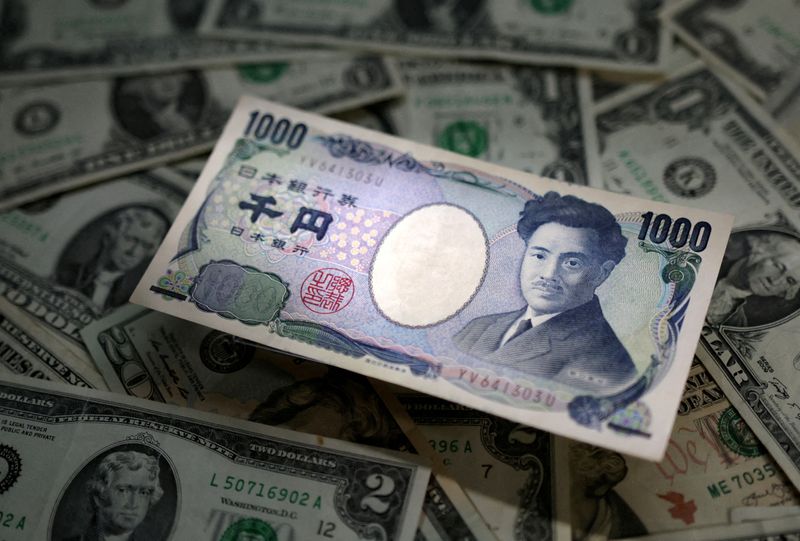Yen slips after BOJ stands pat on ultra-loose policy
2023.12.19 01:42

© Reuters. FILE PHOTO: Japanese Yen and U.S. dollar banknotes are seen in this illustration taken March 10, 2023. REUTERS/Dado Ruvic/Illustration/File Photo/File Photo
By Rae Wee and Summer Zhen
SINGAPORE (Reuters) -The yen fell broadly on Tuesday after the Bank of Japan (BOJ) kept its ultra-loose monetary policy unchanged and maintained its forward guidance in a closely awaited decision at the conclusion of its two-day policy meeting.
The yen slid more than 0.6% against the U.S. dollar to a session-low of 143.78 following the decision, though it later pared some of those losses. The yen last stood at 143.46 per dollar.
Against the euro, the yen likewise weakened to a one-week low of 157, and was last roughly 0.5% lower at 156.72 per euro.
While the outcome was in line with market expectations, some investors were on the lookout for signs on whether the dovish central bank might signal an eventual move away from negative interest rates.
“Before the meeting, there were expectations for policy changes, including wording amendments in the statement,” said SMBC’s chief FX strategist, Hirofumi Suzuki.
“The movement of a weaker (yen) is unlikely to become a trend, partly because expectations remain for a policy revision for January-March next year.”
Market focus now turns to Governor Kazuo Ueda’s press conference later in the day for further guidance on the bank’s policy outlook.
“The BOJ will not hesitate to take additional easing steps if necessary,” the central bank said in a statement, adding that uncertainty regarding the economy was extremely high.
“In an environment where the combined value of the government’s balance sheet alongside other reporting bodies puts it (Japan) at the top of the global gross government debt to GDP tables, it is almost physically impossible to foresee a scenario unfolding whereby the BOJ would not keep monetary policy loose in order to allow the government favourable debt servicing environs,” said Marcel von Pfyffer, CIO of Arminius Capital.
FED PUSHBACK?
In the broader market, the greenback languished near roughly five-month lows against the risk-sensitive Australian and New Zealand dollars, as market sentiment stayed buoyant on the prospect that the U.S. Federal Reserve could begin lowering rates next year.
The edged 0.19% higher to $0.6719, having peaked at $0.6736 in the previous session, its highest since July 31.
The likewise rose 0.25% to $0.62275, standing not too far from Monday’s top of $0.6250.
Minutes from the Reserve Bank of Australia’s December policy meeting out on Tuesday showed the central bank considered hiking interest rates, but decided there were enough encouraging signs on inflation to pause for more data.
Elsewhere, the was little changed at 102.53.
While some Fed officials have pushed back against market expectations of how soon the Federal Open Market Committee (FOMC) could cut rates, those comments have done little to sway market pricing and stem the greenback’s decline.
Chicago Fed President Austan Goolsbee on Monday said the Fed is not pre-committing to cutting rates soon and swiftly, and the jump in market expectations that it will do so is at odds with how the U.S. central bank functions.
“It may take (the) PCE inflation or comments from FOMC Chair (Jerome) Powell to encourage market participants to delay their expectations for the start of the rate cut cycle,” said Joseph Capurso, head of international and sustainable economics at Commonwealth Bank of Australia (OTC:) (CBA).
A reading on the core Personal Consumption Expenditures (PCE) price index – the Fed’s preferred measure of underlying inflation – is due this week, providing further clarity on whether inflation has slowed sufficiently for the Fed to begin easing its monetary policy next year.
Sterling rose 0.08% to $1.2657, while the euro gained 0.04% to $1.09265.
The two currencies, however, remain vulnerable to a dislocation in oil and gas markets, according to CBA’s Capurso, given their increasing dependence on energy from the Middle East.
Attacks by Yemen’s Iran-aligned Houthi militants on ships in the Red Sea disrupted maritime trade and forced companies to reroute vessels, sending oil prices higher as investors worried about disruption to trade as well as supply costs.
“Middle East oil and gas supplies may be put at risk,” said Capurso. “That’s why the euro and sterling are most at risk for big falls if these conflicts get worse or spread.”








